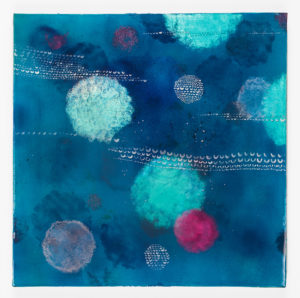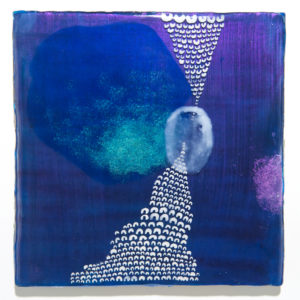
In my last blog post, I introduced you to the idea of including meditation into your daily life as a way to begin tackling those negative internal voices that so often cripple us as artists. I know that a lot of people may be skeptical of how helpful a meditation practice can be, but the benefits of becoming more aware can only serve to help us grow as artists.
A couple of years into my meditation practice, when I was still struggling in the studio with insecurities and self-criticism, I remember a big breakthrough. I was working on a very large painting. It was my largest painting to date and I had invested a lot of time and money making it. But the piece felt flat and unpainterly to me.
I remember one day looking at it and it felt totally unsolvable. I just hated the piece. And I couldn’t think of how to solve it. I was feeling frustrated and discouraged and because I had spent so much on the materials, the thought of abandoning it didn’t seem a viable option. For some reason that day, I had the presence of mind to just stop and sit with it. Not try to think it through or solve it, just be present with it, as I would in meditation. And in that silence, I got an idea for something to try. Since it was about the worst painting I had ever made, I had nothing to lose. When I tried my new idea, I was completely delighted with the results and full of exhilaration and fresh energy for the piece. I broke through what I call “the Wall.”

“The Wall” seems to happen over and over in creative work. It’s when you are at an impasse. You’ve already invested quite a bit into the project. So it definitely feels like more is at stake. It can feel like there’s no way out, no solution.
Sometimes the best way through is to do “nothing.” By nothing I mean to empty oneself and become receptive. Meditation can teach us how to do that.
A daily practice of meditation teaches us to discern between mind chatter and our inner wisdom. It’s easy to get caught up in our thoughts, circling over and over with various possibilities and choices without gaining clarity. Without awareness, our thoughts drive us. Having your thoughts driving you is like being dragged around behind a wild unruly stallion. I am inviting you to learn how to get back in the saddle, and guide your mind by developing a respectful, cooperative relationship with it. When we can get some distance between our self and our thoughts, we can choose our thoughts.
What is remarkable is that when we shine the light of awareness on a problem without identifying with it, this problem tends to become less daunting. In our calm awareness, insights and solutions naturally arise. We may be inspired to action, but without the sense of willfulness and effort we may have formerly applied to similar situations. For example, in the past when I was frustrated with a painting, I might have pushed on through, painting over and over it even though I knew it wasn’t going well and I wasn’t enjoying it. I would apply my willfulness and work ethic, hoping for some kind of resolution. And sometimes that approach does work. But these days, when I am at an impasse, I am more likely to stop, sit quietly, close my eyes and go inward, allowing ideas to enter my head. It never takes long, and the most unexpected and delightful solutions present themselves.
What do you do to break through blocks and barriers to creativity or move past what I call “the Wall” in your own practice? I invite you share your thoughts in the comments below.

Responses to “Art & Meditation: Transforming Barriers to Creativity”
Judy Rattner
Welcome back sounds good
I will pass it on
Michele Theberge
Thanks, Judy!
Christine Swift
I will put my painting on the floor leaning against the cupboard in front of my fav chair and look at it from time to time while I watch tv or have a cuppa, you see things more clearly and the next step comes easily… This can happen many times over the course of a painting, it also helps as imy unable to sit or stand for long due to a car accident, works for me on both levels😄
Michele Theberge
I love it when artists have comfortable chairs in their studios to reflect on their paintings. I finally bought a nice arm chair for my studio but have yet to move it about to sit and contemplate. It always seems like too much trouble! But my fave thing is to take a nap on the futon on the floor in the middle of the day and then look at the paintings with fresh eyes when i first open them. Thanks for sharing, Christine!
carol a levy
Michele: You are terrific!!! I just love that you are out there with the Dharma. Your straight forward being out there sharing your practice with others the way that you do makes a difference to so many. So wise so right on. I appreciate you. As a teacher and Dharma practitioner I do my bit but you reach so many including me. Thank you for the reminders.
Michele Theberge
Carol – You are so kind to say this. Thank you. This is my life’s dream to make a difference to others. Your feedback warms my heart and helps me understand that I am making progress on this path. xo